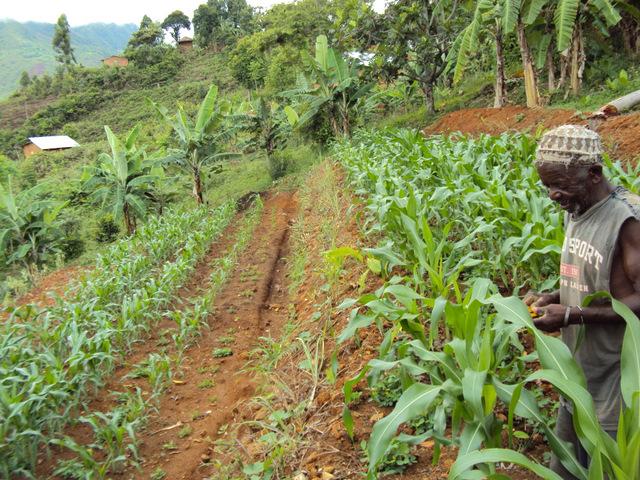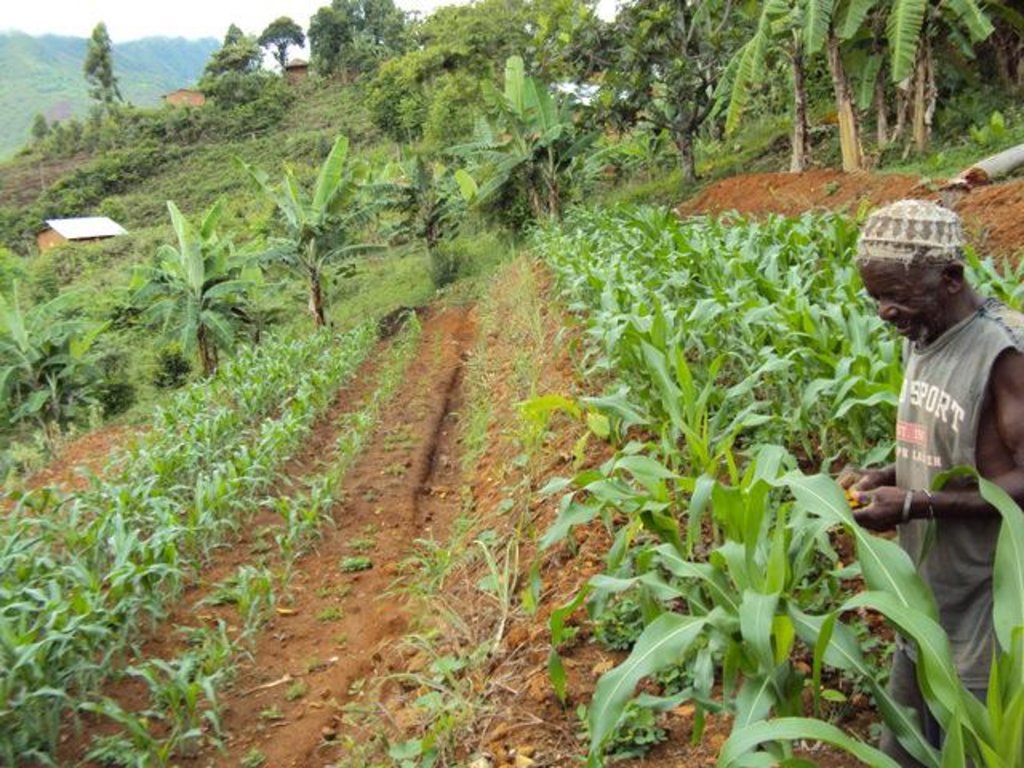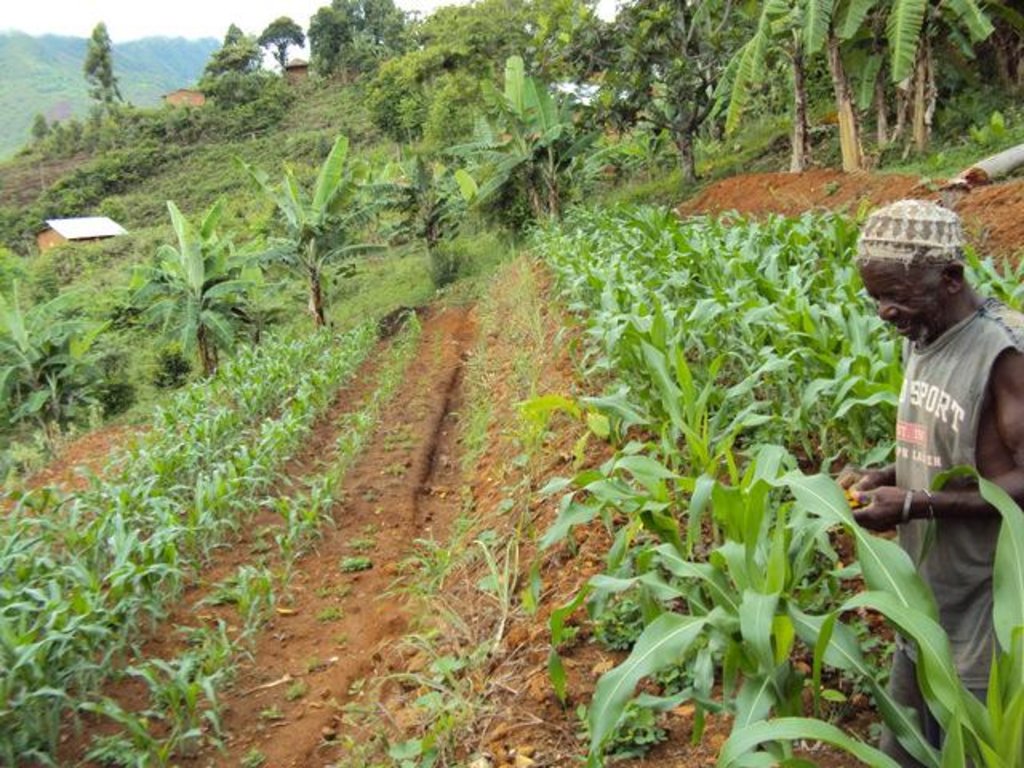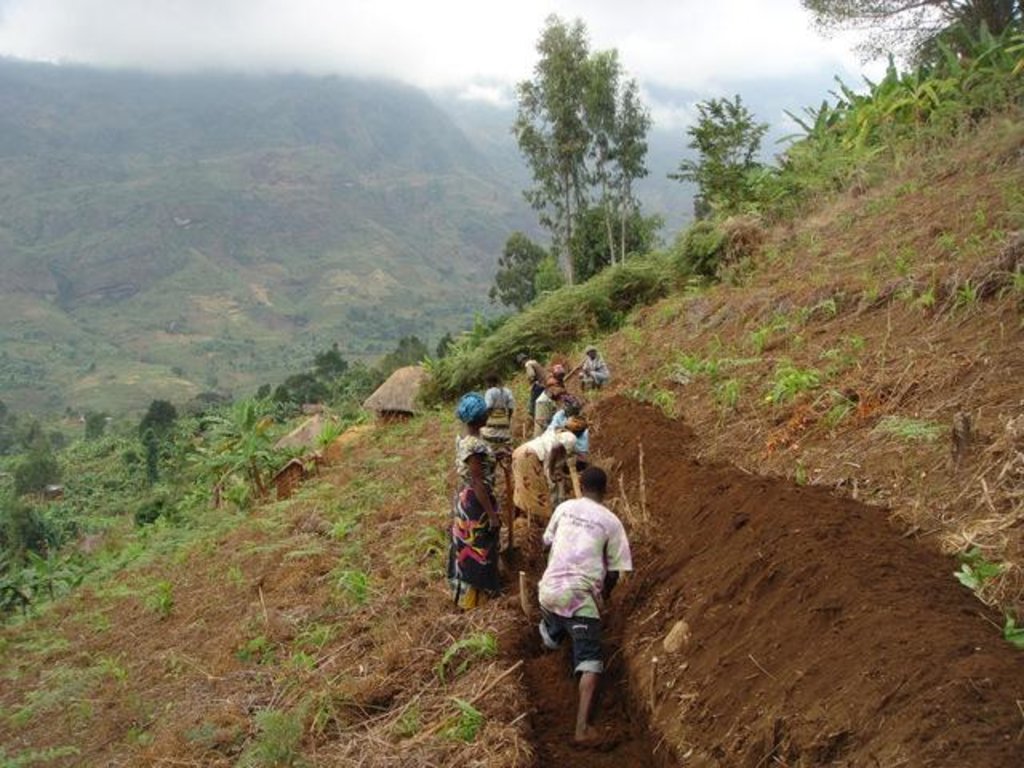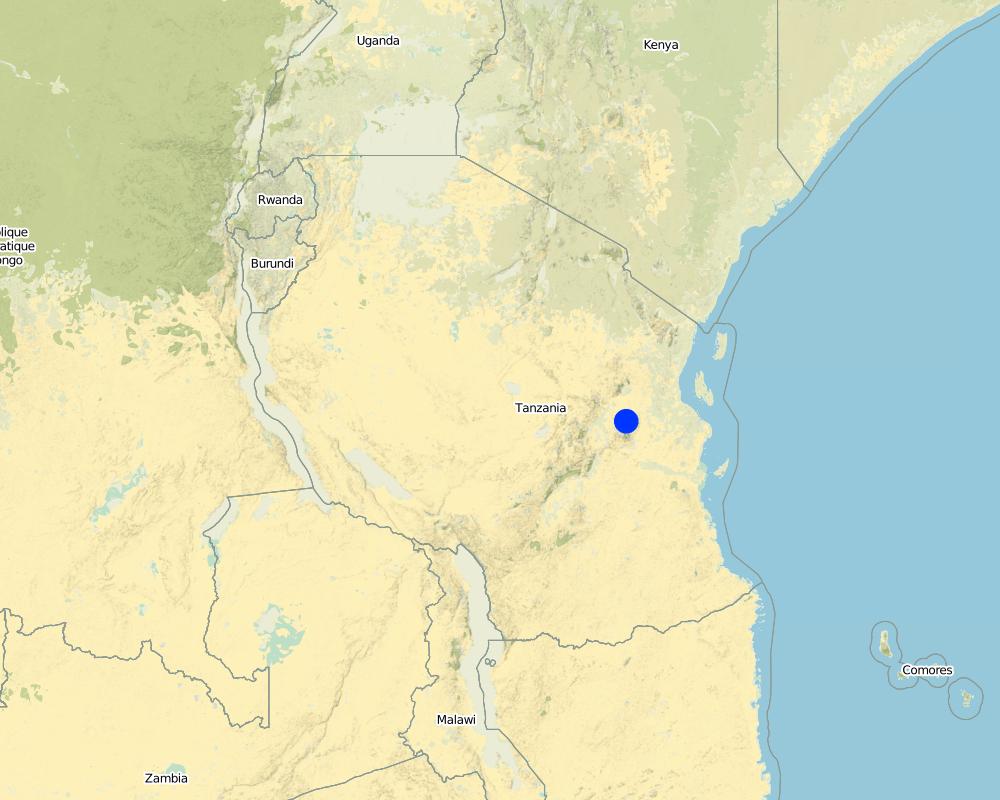Equitable Payments for Watershed Services [แทนซาเนีย]
- ผู้สร้างสรรค์:
- การอัพเดท:
- ผู้รวบรวม: Philippe Zahner
- ผู้เรียบเรียง: –
- ผู้ตรวจสอบ: Fabian Ottiger
approaches_2567 - แทนซาเนีย
ดูส่วนย่อย
ขยายทั้งหมด ย่อทั้งหมด1. ข้อมูลทั่วไป
1.2 รายละเอียดที่ติดต่อได้ของผู้รวบรวมและองค์กรที่เกี่ยวข้องในการประเมินและการจัดเตรียมทำเอกสารของแนวทาง
ผู้เชี่ยวชาญ SLM:
Dosteus Lopa
dosteus.lopa@co.care.org
CARE International in Tanzania
Morogoro
แทนซาเนีย
ชื่อของโครงการซึ่งอำนวยความสะดวกในการทำเอกสารหรือการประเมินแนวทาง (ถ้าเกี่ยวข้อง)
Swiss Agency for Development and Cooperation (DEZA / COSUDE / DDC / SDC) - สวิตเซอร์แลนด์ชื่อของโครงการซึ่งอำนวยความสะดวกในการทำเอกสารหรือการประเมินแนวทาง (ถ้าเกี่ยวข้อง)
CARE International (CARE) - สหรัฐอเมริกา1.3 เงื่อนไขที่เกี่ยวข้องกับการใช้ข้อมูลที่ได้บันทึกไว้ผ่านทาง WOCAT
ผู้รวบรวมและวิทยากรหลักยอมรับเงื่อนไขเกี่ยวกับการใช้ข้อมูลที่ถูกบันทึกผ่านทาง WOCAT:
ใช่
2. คำอธิบายของแนวทาง SLM
2.1 การอธิบายแบบสั้น ๆ ของแนวทาง
Equitable Payments for Watershed Services (EPWS) is a programme using Payments for Ecosystem Services (PES) to improve rural livelihoods.
2.2 การอธิบายอย่างละเอียดของแนวทาง
การอธิบายอย่างละเอียดของแนวทาง:
Aims / objectives: Incentive mechanisms are used to reward upstream landowners for maintaining a beneficial land use or for adapting a particular land use practice which affects the availability and/or quality of downstream water resources. The EPWS approach has enormous potential to advance a new conservation revolution based on a compensation mechanism encouraging and financing conservation efforts as well as improving the livelihoods of the rural poor. EPWS aims to spread SLM technologies to communities, to raise awareness of the benefits of SLM and to improve land productivity. Farmer groups are formed to lead the implementation of SLM.
Methods: The approach includes supervision, support and training of farmers to ensure appropriate implementation of SLM and efficient soil erosion control. Methods include demonstration plots and farmer-to-farmer extension. Capacity building to farmers (on gender mainstreaming, good governance and relevant laws and policies) and monitoring of hydrological and livelihood status are important components of the approach. Efforts to ensure good women integration resulted in a relatively high proportion within the farmer groups (>35%). A payment mechanism has been established to compensate farmers for delivering watershed services (in form of freshwater) through implementation of SLM. Compensation payments – paid in cash and through material support – are made first to establish land use changes, and thereafter for service delivery and maintenance. They are mainly covered through international donors (DANIDA) and ‘buyers’ from the private sector, investing in watershed management.
Role of stakeholders: The EPWS team consisting of CARE International, WWF staffs and short-term workers (such as students) is always involving government staff in various activities to induce them to knowledge on EPWS in particular and the PES concept at large.
Other important information: This PES approach is very new in the country and there is little expertise within the government -which therefore needs to take deliberate efforts to groom experts through seminars and courses on PES mechanisms and its operationalisation
2.3 รูปภาพของแนวทาง
2.5 ประเทศ ภูมิภาค หรือสถานที่ตั้งที่ได้นำแนวทางไปใช้
ประเทศ:
แทนซาเนีย
ข้อมูลเฉพาะเพิ่มเติมของสถานที่ตั้ง:
Morogoro
Map
×2.7 ประเภทของแนวทาง
- ใช้โครงงานหรือแผนงานเป็นฐาน
2.8 เป้าหมายหรือวัตถุประสงค์หลักของแนวทาง
The Approach focused mainly on SLM with other activities (Improvement of livelihoods, improvement of hydrological system)
Improve livelihoods through SLM / Improvement of hydrological system / Mechanism to ensure effectiveness, growth and sustainability of EPWS / Enhance quality of program implementation
The SLM Approach addressed the following problems: Land cover changes due to extensive cultivations / Deforestation and forest degradation / Soil erosion, loss of soil fertility / Low storage capacity of the Uluguru Mountains due to land cover change / Declining amount of available water in the river coming from Uluguru Mts / Increased run-off and sediment load in water system due to bare lands
3. การมีส่วนร่วมและบทบาทของผู้มีส่วนได้ส่วนเสียที่เกี่ยวข้อง
3.1 ผู้มีส่วนได้ส่วนเสียที่เกี่ยวข้องในแนวทางนี้และบทบาท
- ผู้ใช้ที่ดินระดับท้องถิ่นหรือชุมชนระดับท้องถิ่น
Efforts to ensure good women integration resulted in a relatively high proportion within the farmer groups (>35%).
- ผู้เชี่ยวชาญ SLM หรือที่ปรึกษาการเกษตร
experts on hydrology, GIS, SWC, economics, forests, etc.
- องค์กรพัฒนาเอกชน
DAWASCO
- ภาคเอกชน
Coca Cola KLtd
- รัฐบาลระดับท้องถิ่น
Morogoro district council
district commissioners, ward councillors
- องค์การระหว่างประเทศ
DANIDA, CARE International Tanzania, WWF Tanzania
3.2 การเกี่ยวข้องของผู้ใช้ที่ดินระดับท้องถิ่นหรือชุมชนระดับท้องถิ่นในช่วงต่างๆของแนวทาง
| ความเกี่ยวข้องของผู้ใช้ที่ดินระดับท้องถิ่นหรือชุมชนระดับท้องถิ่น | ระบุผู้ที่มีส่วนเกี่ยวข้องและอธิบายกิจกรรม | |
|---|---|---|
| การริเริ่มหรือการจูงใจ | ไม่มี | |
| การวางแผน | ปฏิสัมพันธ์ | |
| การดำเนินการ | จ่ายเงินหรือสนับสนุนจากภายนอก | Farmers are being compensated (paid in cash) for labour and area provided for the implementation of SLM (opportunity costs). Material support through manure, seeds and working tools is given as well. |
| การติดตามตรวจสอบหรือการประเมินผล | ไม่มี | |
| Research | ไม่มี |
3.4 การตัดสินใจเลือกใช้เทคโนโลยี SLM
ระบุผู้ที่ทำการตัดสินใจเลือกเทคโนโลยีมากกว่าหนึ่งวิธีไปปฏิบัติใช้:
- ผู้เชี่ยวชาญ SLM เป็นผู้ตัดสินใจหลัก ที่ติดตามให้คำปรึกษากับผู้ใช้ที่ดิน
การอธิบาย:
Interactive implementation and decision making; participatory feasibility studies to identify the core problems; PRA to identify and agree on SLM technologies; government staff was involved in various activities e.g. planning, training, data collection and analysis, extension, etc.
Decisions on the method of implementing the SLM Technology were made by mainly by land users supported by SLM specialists
4. การสนับสนุนด้านเทคนิค การสร้างขีดความสามารถ และการจัดการด้านความรู้
4.1 การสร้างขีดความสามารถ / การอบรม
ได้มีการจัดอบรมให้แก่ผู้ใช้ที่ดินหรือผู้มีส่วนได้ส่วนเสียคนอื่น ๆ หรือไม่:
ใช่
ให้ระบุว่าใครเป็นผู้ได้รับการอบรม:
- ผู้ใช้ที่ดิน
รูปแบบการอบรม:
- เกษตรกรกับเกษตรกร
- ใช้พื้นที่ทำการสาธิต
หัวข้อที่พูด:
practical skills on SLM measures, leadership skills, governance, gender mainstreaming, policies and laws to ensure their understanding on the implementation of the EPWS project in their locality
4.2 การบริการให้คำแนะนำ
ผู้ใช้ที่ดินมีการเข้าถึงการรับบริการให้คำปรึกษาหรือไม่:
ใช่
ระบุว่ามีบริการให้คำปรึกษาหรือไม่:
- ไปเยี่ยมชมสถานที่
การอธิบาย/แสดงความคิดเห็น:
Key elements: technical support on monitoring, provision of extension services for improved land use, situation analysis, awareness creation, capacity building on legal issues and mapping of interventions; People involved: University, foresters, hydrologists, Ministry of agriculture, land use planners
4.3 การเสริมความแข็งแกร่งให้กับสถาบัน (การพัฒนาองค์กร)
สถาบันได้รับการจัดตั้งขึ้นมาหรือเสริมความแข็งแกร่งโดยแนวทางนี้หรือไม่:
- ไม่
4.4 การติดตามตรวจสอบและประเมินผล
การติดตามตรวจสอบและประเมินผลเป็นส่วนหนึ่งของแนวทางหรือไม่:
ใช่
ความคิดเห็น:
bio-physical aspects were monitored through measurements
socio-cultural aspects were monitored through observations
economic / production aspects were monitored through observations
4.5 การวิจัย
การวิจัยเป็นส่วนหนึ่งของแนวทางหรือไม่:
ใช่
ระบุหัวข้อเรื่อง:
- สังคมวิทยา
- เศรษฐศาสตร์หรือการตลาด
- นิเวศวิทยา
ให้ข้อมูลเพิ่มเติมและให้ระบุผู้ทำการวิจัย:
Research is a main part of PES as an approach to facilitate SLM adoption and has been very effective in guiding programme design; it included SLM assessment, hydrological analysis, economic analysis, social and livelihoods assessment, etc. All interventions applied were proposed by research conducted before and during implementation.
Research was carried out on-farm
5. การสนับสนุนด้านการเงินและวัสดุอุปกรณ์
5.1 ระบุงบประมาณประจำปีสำหรับแนวทาง SLM นี้
ถ้าหากว่างบประมาณประจำปีไม่เป็นที่ทราบแน่นอน ให้ระบุช่วงลงไป:
- 10,000-100,000
แสดงความคิดเห็น (แหล่งของการระดมทุน ผู้บริจาคคนสำคัญ):
Approach costs were met by the following donors: international (DANIDA): 60.0%; private sector ('buyers' of ecosystem service): 9.0%; local community / land user(s) (through labour power): 31.0%
5.2 การสนับสนุนด้านการเงิน / วัสดุอุปกรณ์ให้แก่ผู้ใช้ที่ดิน
ผู้ใช้ที่ดินได้รับการสนับสนุนด้านการเงิน / วัสดุอุปกรณ์ไปปฏิบัติใช้เทคโนโลยีหรือไม่:
ใช่
5.3 เงินสนับสนุนสำหรับปัจจัยนำเข้า (รวมถึงแรงงาน)
- การเกษตร
| ระบุปัจจัยนำเข้าที่ได้รับการสนับสนุน | เห็นด้วยระดับไหน | ระบุเงินสนับสนุน |
|---|---|---|
| เมล็ด | ได้รับการช่วยเหลือทางการเงินบางส่วน | |
| ปุ๋ย | ได้รับการช่วยเหลือทางการเงินบางส่วน | |
ถ้าแรงงานโดยผู้ใช้ที่ดินเป็นปัจจัยนำเข้าที่มีอยู่มากมาย ระบุด้วยว่าเนื่องจาก:
- จ่ายเป็นเงินสด
ความคิดเห็น:
Farmers are being compensated (paid in cash) for labour and area provided for the implementation of SLM (opportunity costs). Material support through manure, seeds and working tools is given as well.
5.4 เครดิต
มีการจัดหาเครดิตมาให้ภายใต้แนวทาง SLM หรือไม่:
ไม่ใช่
6. การวิเคราะห์ผลกระทบและการสรุป
6.1 ผลกระทบของแนวทาง
ช่วยให้ผู้ใช้ที่ดินนำเอาเทคโนโลยี SLMไปใช้และบำรุงรักษาสภาพไว้ได้หรือไม่:
- ไม่ใช่
- ใช่ เล็กน้อย
- ใช่ ปานกลาง
- ใช่ อย่างมาก
increased production
ทำให้กลุ่มด้อยโอกาสมีอำนาจทางสังคมและเศรษฐกิจหรือไม่:
- ไม่ใช่
- ใช่ เล็กน้อย
- ใช่ ปานกลาง
- ใช่ อย่างมาก
women have gained training in improving land use practices
Did other land users / projects adopt the Approach?
- ไม่ใช่
- ใช่ เล็กน้อย
- ใช่ ปานกลาง
- ใช่ อย่างมาก
Upscaling to neighbouring villages will be facilitated by the establishment of networks of farmers groups to receive training by local extension services. A steering committee, with representatives of the farmers, investors and government offices will facilitate replication in other parts of the country.
Did the Approach lead to improved livelihoods / human well-being?
- ไม่ใช่
- ใช่ เล็กน้อย
- ใช่ ปานกลาง
- ใช่ อย่างมาก
Did the Approach help to alleviate poverty?
- ไม่ใช่
- ใช่ เล็กน้อย
- ใช่ ปานกลาง
- ใช่ อย่างมาก
through change of crop production
6.2 แรงจูงใจหลักของผู้ใช้ที่ดินเพื่อที่จะนำ SLM ไปปฏิบัติใช้
- การจ่ายเงินหรือการช่วยเหลือ
- การเข้าร่วมสมทบในขบวนการ โครงการ กลุ่ม เครือข่าย
- จิตสำนึกด้านสิ่งแวดล้อม
- well-being and livelihoods improvement
6.3 ความยั่งยืนของกิจกรรมของแนวทาง
ผู้ใช้ที่ดินสามารถทำให้สิ่งต่างๆ ที่ได้ปฏิบัติใช้โดยแนวทางนี้ยั่งยืนได้หรือไม่ (โดยไม่มีการสนับสนุนจากภายนอก):
- ใช่
ถ้าตอบว่าใช่ ให้อธิบายว่าอย่างไร :
Participant land users can continue the activity without additional support- maintenance costs are low and the technologies will improve productivity and resilience of farming system. Upscaling to neighbouring villages will be facilitated by the establishment of networks of farmers groups to receive training by local extension services. A steering committee, with representatives of the farmers, investors and government offices will facilitate replication in other parts of the country.
6.4 จุดแข็งและข้อได้เปรียบของแนวทาง
| จุดแข็ง / ข้อได้เปรียบของแนวทางในทัศนคติของผู้รวบรวมหรือวิทยากรหลัก |
|---|
| PES as an additional argument for supporting property claims |
| To ensure services are delivered and payments are made and a reliable monitoring mechanism has been put in place |
| Poor people are in the centre of the objectives |
| Approach rewards land users for providing watershed services |
| PES as an incentive for conservation, helping to change land users’ vision towards improved land management |
| Once measures are applied they are simple and cheap to maintain |
6.5 จุดอ่อน / ข้อเสียเปรียบของแนวทางและวิธีในการแก้ไข
| จุดอ่อน / ข้อเสียเปรียบในทัศนคติของผู้รวบรวมหรือวิทยากรหลัก | สามารถแก้ไขปัญหาได้อย่างไร |
|---|---|
| May reduce the effectiveness of non-incentive based approaches as people will now demand rewards/payments | awareness creation is important to all players including government and local communities |
| Payments / rewards are realised before service delivery | ensure integration of PES with other approaches to ensure effectives short and long term benefits. Paying labour cost upfront while waiting for the service delivery rewards |
7. การอ้างอิงและการเชื่อมต่อ
7.1 วิธีการหรือแหล่งข้อมูล
- ไปเยี่ยมชมภาคสนาม การสำรวจพื้นที่ภาคสนาม
- การสัมภาษณ์กับผู้ใช้ที่ดิน
ลิงก์และโมดูล
ขยายทั้งหมด ย่อทั้งหมดลิงก์
ไม่มีลิงก์
โมดูล
ไม่มีโมดูล


